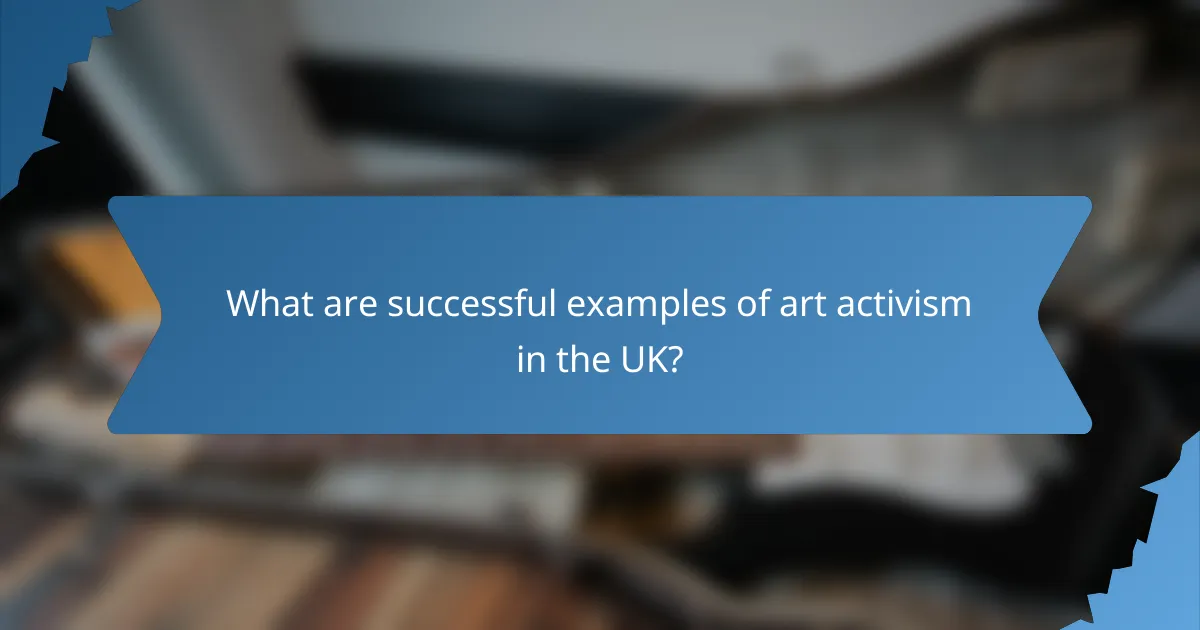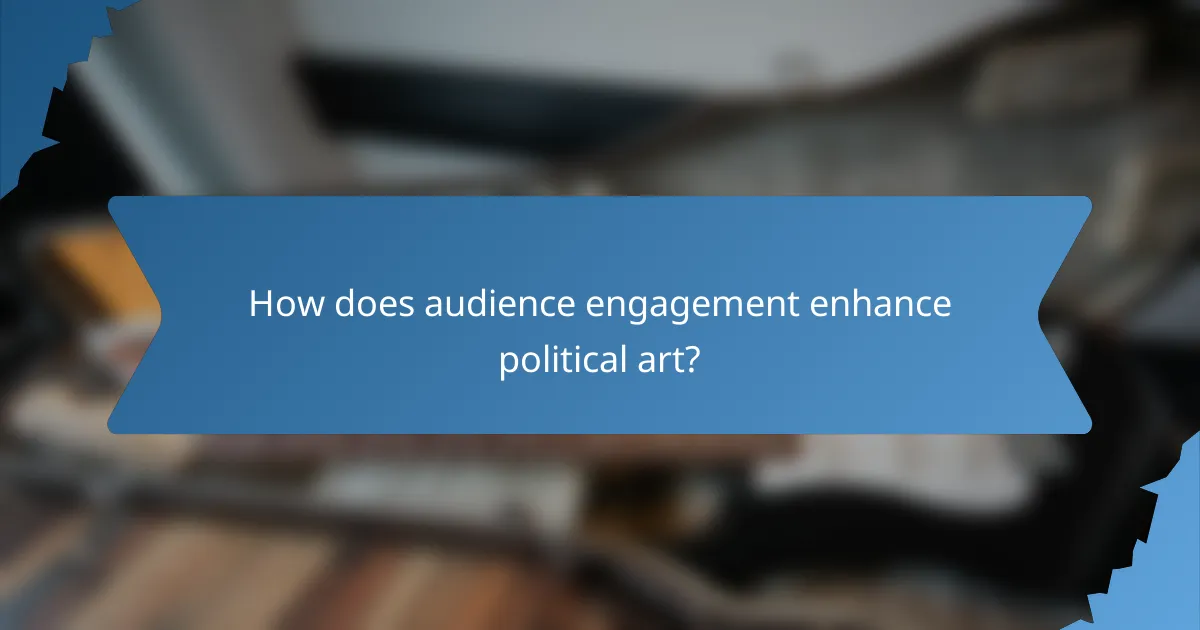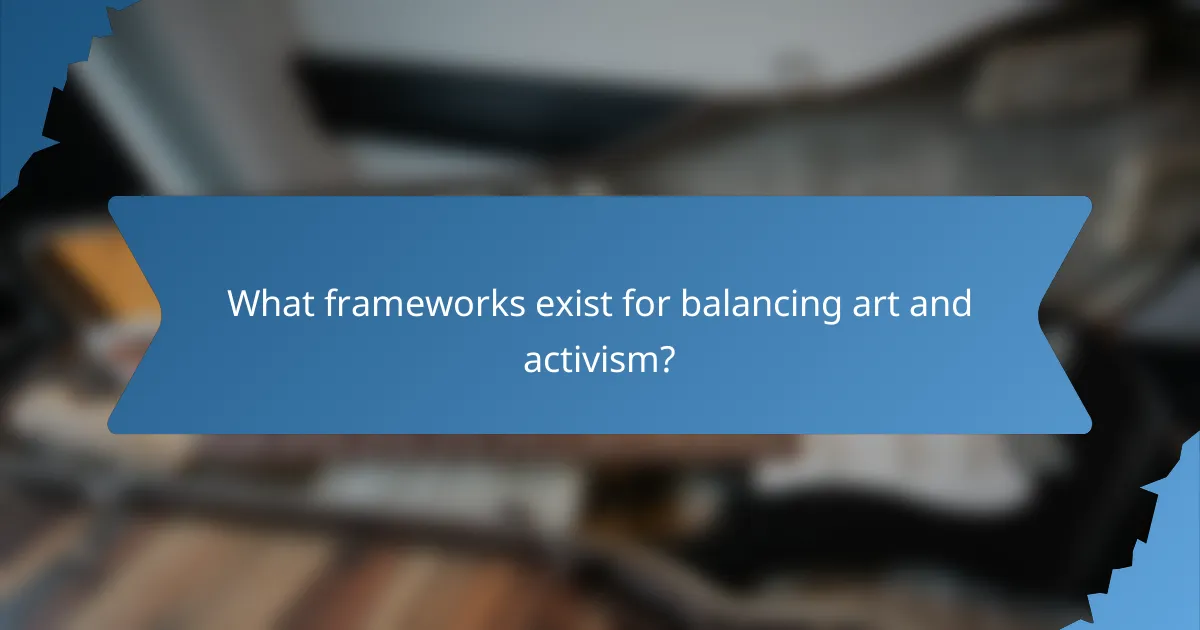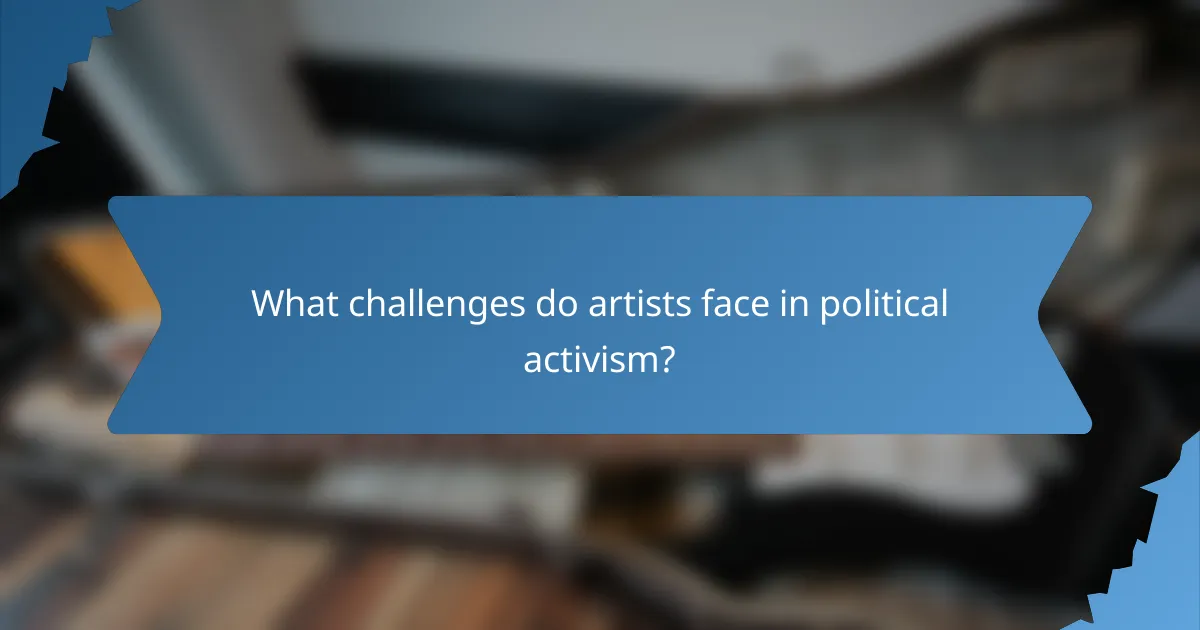Balancing art and activism is a powerful approach that allows creative expression to serve as a vehicle for political messaging. By integrating visual symbolism and addressing social issues, artists can engage audiences on both emotional and intellectual levels, fostering meaningful dialogue about important societal matters. This dynamic relationship enhances the impact of the artwork, encouraging viewers to not only absorb the message but also actively participate in the conversation.

How can art effectively convey political messages in the UK?
Art can effectively convey political messages in the UK by using visual symbolism, integrating social issues, and providing historical context. These elements engage audiences emotionally and intellectually, prompting reflection and dialogue about pressing societal matters.
Use of visual symbolism
Visual symbolism is a powerful tool in art that can encapsulate complex political ideas into easily recognizable images. For instance, the use of the Union Jack in various artworks can evoke national identity while simultaneously critiquing government policies. Artists should consider how symbols resonate with their audience to enhance the impact of their messages.
When employing visual symbolism, clarity is key. Artists should avoid overly abstract representations that may confuse viewers. Instead, focusing on universally understood symbols can help convey messages more effectively.
Integration of social issues
Integrating social issues into artistic expression allows artists to address contemporary challenges such as inequality, climate change, and human rights. For example, street art often highlights local social struggles, making the art accessible and relevant to the community. This approach fosters a connection between the artwork and the audience, encouraging active engagement.
Artists should strive to present social issues in a way that invites discussion rather than alienation. Balancing emotional appeal with factual representation can enhance the effectiveness of the message and broaden its reach.
Historical context in artworks
Incorporating historical context into artworks can deepen the audience’s understanding of current political messages. By referencing past events, artists can draw parallels that highlight ongoing struggles or successes in social justice. For example, works that reflect on the suffragette movement resonate with contemporary discussions about gender equality.
Artists should research relevant historical events and movements to inform their work. Providing context through exhibitions or artist statements can help audiences grasp the significance of the artwork and its political implications.

What are successful examples of art activism in the UK?
Successful examples of art activism in the UK blend creative expression with political messaging to engage audiences and provoke thought. These projects often address social issues and inspire action through various artistic mediums.
Banksy’s political murals
Banksy’s political murals are iconic representations of art activism in the UK. His works often tackle themes such as war, consumerism, and social injustice, using humor and irony to convey powerful messages. For instance, his mural “Girl with a Balloon” critiques the fleeting nature of hope and innocence.
These murals not only beautify urban spaces but also spark conversations and debates among viewers. Banksy’s ability to capture public sentiment has made his art a catalyst for social change, encouraging audiences to reflect on pressing issues.
Grayson Perry’s exhibitions
Grayson Perry’s exhibitions combine personal narrative with broader societal commentary, making them a significant part of UK art activism. His works often explore themes of identity, gender, and class, inviting viewers to engage with complex social issues through a personal lens. Perry’s use of ceramics and tapestries adds a unique dimension to his storytelling.
Exhibitions like “The Most Popular Art Exhibition Ever!” have attracted diverse audiences, showcasing how art can foster dialogue about contemporary issues. By blending humor with poignant observations, Perry encourages viewers to reconsider their perspectives on societal norms.
Art Against Knives initiative
The Art Against Knives initiative is a collaborative project that uses art to address knife crime and youth violence in the UK. By engaging young people in creative workshops, the initiative aims to empower them and provide a platform for self-expression. Participants create art that reflects their experiences and challenges, fostering a sense of community and resilience.
This initiative not only raises awareness about the impact of violence but also offers practical support to at-risk youth. By showcasing their artwork in public spaces, Art Against Knives helps to shift perceptions and encourages constructive conversations around safety and prevention.

How does audience engagement enhance political art?
Audience engagement significantly enhances political art by fostering a deeper connection between the artwork and its viewers. When audiences actively participate, they not only absorb the message but also contribute to the dialogue, making the art more impactful and relevant.
Interactive installations
Interactive installations invite viewers to engage physically and emotionally with the artwork, transforming passive observation into active participation. For example, installations that require audience input can reflect real-time data or responses, creating a dynamic experience that evolves with each interaction.
Consider using technology like sensors or projections to create immersive environments. This approach can lead to heightened awareness of social issues, as participants become part of the narrative, making the message resonate more strongly.
Community-driven projects
Community-driven projects emphasize collaboration, allowing local voices to shape the artistic expression. These initiatives often involve workshops or forums where community members can share their stories and perspectives, which are then incorporated into the artwork.
Such projects can take various forms, from murals to public performances, and are particularly effective in addressing local issues. Engaging the community ensures that the art reflects genuine experiences and fosters a sense of ownership and pride among participants.
Social media campaigns
Social media campaigns amplify political art by reaching broader audiences and facilitating immediate dialogue. Artists can share their work online, encouraging followers to engage through comments, shares, and even user-generated content that aligns with the campaign’s message.
Effective social media strategies often include hashtags, challenges, or collaborative posts that invite audience participation. This not only spreads awareness but also creates a sense of community among supporters, driving collective action and engagement around political issues.

What frameworks exist for balancing art and activism?
Frameworks for balancing art and activism include various approaches that integrate creative expression with political messaging while engaging audiences effectively. These frameworks help artists navigate the complexities of conveying their messages without compromising their artistic integrity or alienating their audience.
Ethical considerations in art
Ethical considerations in art involve understanding the impact of creative expression on society and the responsibilities artists have towards their subjects and audiences. Artists should be mindful of cultural sensitivities, representation, and the potential consequences of their work.
For instance, when addressing social issues, artists must avoid exploitation or misrepresentation of marginalized communities. Engaging with these communities in a respectful manner can enhance authenticity and foster trust.
Art funding and sponsorship guidelines
Art funding and sponsorship guidelines are crucial for maintaining the integrity of artistic projects while pursuing financial support. Artists should seek funding sources that align with their values and mission, ensuring that sponsors do not impose restrictions that could compromise their message.
When considering sponsorship, it’s essential to evaluate the sponsor’s reputation and the potential public perception of the partnership. Clear communication about the terms of sponsorship can help prevent conflicts and maintain artistic freedom.

What challenges do artists face in political activism?
Artists engaged in political activism often confront significant challenges that can hinder their creative expression and impact. These challenges include censorship, funding limitations, and potential backlash from the public.
Censorship issues
Censorship is a major hurdle for artists involved in political activism, as their work may be restricted or suppressed by authorities or institutions. This can manifest in various forms, such as the removal of artworks from exhibitions or restrictions on public performances.
Artists must navigate the fine line between expressing their views and adhering to regulations that may limit their freedom of speech. Understanding local laws and cultural sensitivities is crucial to avoid potential legal repercussions.
Funding limitations
Securing funding for politically charged art projects can be challenging, as many sponsors may shy away from controversial topics. Artists often rely on grants, crowdfunding, or partnerships with organizations that support social change.
To enhance funding opportunities, artists should clearly articulate their mission and the impact of their work. Building a strong network and engaging with communities can also attract financial support and resources.
Public reception and backlash
Artists face the risk of negative public reception and backlash when addressing political issues through their work. This can range from criticism on social media to protests against their exhibitions or performances.
To mitigate backlash, artists should consider their audience and the potential interpretations of their work. Engaging in dialogue with community members and being open to feedback can foster understanding and reduce the likelihood of adverse reactions.
